Related Research Articles

Ferromagnetism is a property of certain materials that results in a significant, observable magnetic permeability, and in many cases, a significant magnetic coercivity, allowing the material to form a permanent magnet. Ferromagnetic materials are noticeably attracted to a magnet, a consequence of their substantial magnetic permeability.

Mu-metal is a nickel–iron soft ferromagnetic alloy with very high permeability, which is used for shielding sensitive electronic equipment against static or low-frequency magnetic fields.

A magnet is a material or object that produces a magnetic field. This magnetic field is invisible but is responsible for the most notable property of a magnet: a force that pulls on other ferromagnetic materials, such as iron, steel, nickel, cobalt, etc. and attracts or repels other magnets.
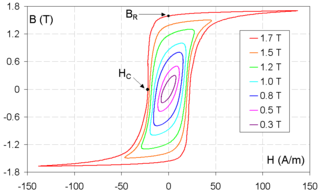
Coercivity, also called the magnetic coercivity, coercive field or coercive force, is a measure of the ability of a ferromagnetic material to withstand an external magnetic field without becoming demagnetized. Coercivity is usually measured in oersted or ampere/meter units and is denoted HC.
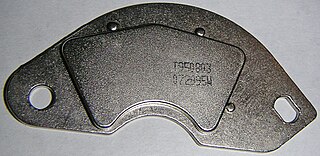
A neodymium magnet (also known as NdFeB, NIB or Neo magnet) is a permanent magnet made from an alloy of neodymium, iron, and boron to form the Nd2Fe14B tetragonal crystalline structure. They are the most widely used type of rare-earth magnet.

Alnico is a family of iron alloys which in addition to iron are composed primarily of aluminium (Al), nickel (Ni), and cobalt (Co), hence the acronym al-ni-co. They also include copper, and sometimes titanium. Alnico alloys are ferromagnetic, and are used to make permanent magnets. Before the development of rare-earth magnets in the 1970s, they were the strongest type of permanent magnet. Other trade names for alloys in this family are: Alni, Alcomax, Hycomax, Columax, and Ticonal.
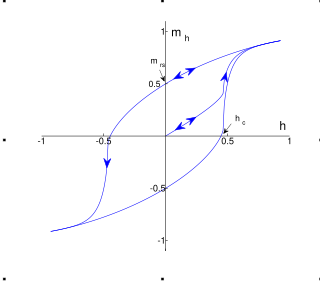
Magnetic hysteresis occurs when an external magnetic field is applied to a ferromagnet such as iron and the atomic dipoles align themselves with it. Even when the field is removed, part of the alignment will be retained: the material has become magnetized. Once magnetized, the magnet will stay magnetized indefinitely. To demagnetize it requires heat or a magnetic field in the opposite direction. This is the effect that provides the element of memory in a hard disk drive.

A voice coil is the coil of wire attached to the apex of a loudspeaker cone. It provides the motive force to the cone by the reaction of a magnetic field to the current passing through it.

A pickup is a transducer that captures or senses mechanical vibrations produced by musical instruments, particularly stringed instruments such as the electric guitar, and converts these to an electrical signal that is amplified using an instrument amplifier to produce musical sounds through a loudspeaker in a speaker enclosure. The signal from a pickup can also be recorded directly.
A samarium–cobalt (SmCo) magnet, a type of rare-earth magnet, is a strong permanent magnet made of two basic elements: samarium and cobalt.
Vicalloy is a family of cobalt-iron-vanadium wrought ferromagnetic alloys which have high coercivity and are used to make permanent magnets and other magnetic components. Vicalloy is precipitation hardened and can be formed by a number of cold working techniques. It is commonly used in electromechanical device applications, such as Wiegand wires because it shows a large Wiegand effect.
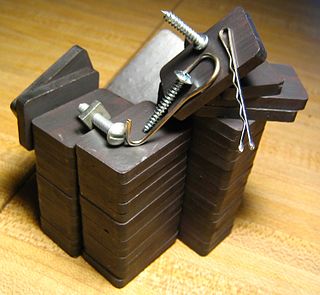
A ferrite is a ceramic material made by mixing and firing iron(III) oxide with one or more additional metallic elements, such as strontium, barium, manganese, nickel, and zinc. They are ferrimagnetic, meaning they are attracted by magnetic fields and can be magnetized to become permanent magnets. Unlike other ferromagnetic materials, most ferrites are not electrically conductive, making them useful in applications like magnetic cores for transformers to suppress eddy currents. Ferrites can be divided into two families based on their resistance to being demagnetized.

The Fender Wide Range Humbucker is a humbucker guitar pickup, designed by Seth Lover for Fender in the early 1970s. This pickup was intended to break Fender's image as a "single coil guitar company," and to gain a foothold in the humbucker guitar market dominated by Gibson.
Glass-coating is a process invented in 1924 by G. F. Taylor and converted into production machine by Ulitovski for producing fine glass-coated metal filaments only a few micrometres in diameter.

The Lace Sensor is a guitar pickup designed by Don Lace and manufactured by AGI since 1985. Lace Sensors are true single coil pickups; however, internally they are different from classic single coils. The chief difference is that, like the pickups used on the Fender Jaguar, the coil is surrounded by metal barriers which are designed to reduce electromagnetic interference such as power line hum. According to the manufacturer, these barriers also help concentrate the magnetic field, allowing weaker magnets to be used, which results in less string pull. This line of electric guitar pickups was used exclusively by Fender from 1985 to 1996.

Magnet wire or enameled wire is a copper or aluminium wire coated with a very thin layer of insulation. It is used in the construction of transformers, inductors, motors, generators, speakers, hard disk head actuators, electromagnets, electric guitar pickups, and other applications that require tight coils of insulated wire.
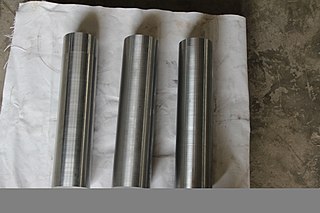
Permendur is a cobalt-iron soft ferromagnetic alloy with equal parts of cobalt and iron which is notable for its high magnetic saturation level. Its saturation flux density of around 2.4 tesla is the highest of any commercially available metal. Coupled with its low coercivity and core losses, its high saturation and permeability makes Permendur useful as magnetic cores in transformers, electric generators and other electrical equipment. The advantage of high saturation in a magnetic core is that it can function at higher magnetic field strengths, so the core can be smaller and lighter for a given magnetic flux and power level. Permendur is used for magnetic cores and pole pieces in lightweight transformers and electric motors used in aircraft. The alloy was invented in 1929 by Gustav Elmen at Bell Telephone Laboratories. Various formulations are sold under different trade names.

The Fender Noiseless series is a line of electric guitar pickups made by the Fender Musical Instruments Corporation designed to cancel 60 cycle (Hz) hum noise while retaining the characteristic sound of single coil pickups. Introduced in 1998, these pickups consist of a pair of single coils stacked one on top of the other, compacted so as to match the shape and width space as a traditional Fender single coil guitar pickup, while being only slightly taller. The upper coil is actually the sound source, while the lower coil is responsible for the mains hum attenuation. Alnico V magnetic bars span from one coil to the other, crossing a soft ferrous steel spacer plate that isolates them, without touching it. The spacer plate has mainly two functions: to isolate the lower coil from the vibrations of the string, making sure that the sound is picked up only from the upper one, and to increase the magnetic flux that passed through both coils, increasing the output of the pickup. This is to be contrasted with the original noise canceling pickup, the humbucker, which is a double-wide, horizontally adjacent pair of single coil pickups with opposing phase.
An electropermanent magnet or EPM is a type of permanent magnet in which the external magnetic field can be switched on or off by a pulse of electric current in a wire winding around part of the magnet. The magnet consists of two sections, one of "hard" magnetic material and one of "soft" material. The direction of magnetization in the latter piece can be switched by a pulse of current in a wire winding about the former. When the magnetically soft and hard materials have opposing magnetizations, the magnet produces no net external field across its poles, while when their direction of magnetization is aligned the magnet produces an external magnetic field.

A permanent magnet motor is a type of electric motor that uses permanent magnets for the field excitation and a wound armature. The permanent magnets can either be stationary or rotating; interior or exterior to the armature for a radial flux machine or layered with the armature for an axial flux topology. The schematic shows a permanent magnet motor with stationary magnets outside of a brushed armature.
References
- ↑ Irvin L. Cooter, Robert E. Mundy, "Cunife wire magnets of small size", Journal of Research of the National Bureau of Standards, vol. 59, no. 6, pp. 379-382, December 1957.
- ↑ Seth Lover, interviewed 1992 by Tony Bacon
- ↑ "Fender American Original '70s Telecaster Custom review". Music Radar. Future Publishing Limited. August 2020. Retrieved 24 August 2020.